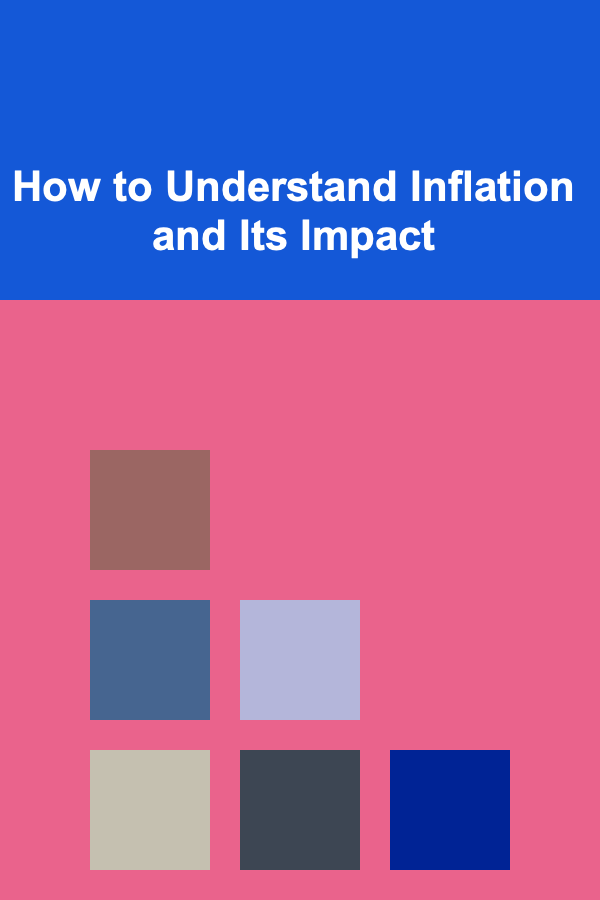
How to Understand Inflation and Its Impact
ebook include PDF & Audio bundle (Micro Guide)
$12.99$5.99
Limited Time Offer! Order within the next:

Inflation is one of the most fundamental concepts in economics, affecting individuals, businesses, governments, and entire economies. It plays a central role in economic policy and is often used as a barometer for the health of an economy. While inflation can seem like an abstract or complex subject, understanding it is crucial for making informed decisions about personal finances, investments, and policy.
In this article, we will explore what inflation is, the different types of inflation, how it is measured, its causes, and its far-reaching effects on individuals and the broader economy. We will also examine the policies that governments use to control inflation, and discuss how inflation can affect various aspects of life, from wages to the cost of living, to economic growth.
What is Inflation?
Inflation refers to the general increase in the prices of goods and services over time within an economy. As inflation rises, the purchasing power of money declines, meaning that a unit of currency buys fewer goods and services than it did before. For example, if the inflation rate is 2% per year, a product that costs $100 this year will cost $102 next year.
While inflation is often associated with rising prices, it is important to note that not all prices increase uniformly. The rate of inflation can vary depending on the type of goods and services involved, and certain sectors may experience price increases or decreases at different rates.
Key Points about Inflation:
- Increase in Prices: Inflation causes the average price of goods and services to rise.
- Decrease in Purchasing Power: As inflation increases, the purchasing power of money decreases.
- Measuring Inflation: Inflation is measured using indexes such as the Consumer Price Index (CPI).
- Impact on Economic Decision-Making: High or low inflation can influence decisions related to saving, investing, and spending.
Types of Inflation
There are several types of inflation, each with its own underlying causes and economic consequences:
1. Demand-Pull Inflation
Demand-pull inflation occurs when the demand for goods and services exceeds the supply. This increased demand "pulls" prices higher as businesses respond to the higher demand by raising their prices. It is most commonly associated with a growing economy in which consumer confidence is high, wages are increasing, and more people are willing to spend.
Causes of Demand-Pull Inflation:
- Economic expansion
- Increased government spending
- Higher consumer spending due to lower interest rates
- Growth in wages and salaries that increases purchasing power
2. Cost-Push Inflation
Cost-push inflation happens when the costs of production rise, causing businesses to increase prices to maintain their profit margins. This type of inflation can result from higher costs of raw materials, wages, or energy prices. For example, if the price of oil rises, the cost of transporting goods will increase, leading to higher prices for a wide range of products.
Causes of Cost-Push Inflation:
- Rising labor costs
- Increases in the cost of raw materials
- Higher energy prices (e.g., oil, gas)
- Supply chain disruptions
3. Built-In Inflation
Also known as wage-price inflation, built-in inflation is a result of the feedback loop between wages and prices. When workers demand higher wages due to the rising cost of living, businesses often pass on these higher labor costs to consumers by increasing prices. In turn, workers demand even higher wages, creating a cycle of rising wages and prices.
Causes of Built-In Inflation:
- Workers demanding higher wages to keep up with inflation
- Businesses raising prices to cover higher wage costs
- The inflation cycle that becomes ingrained in the economy
4. Hyperinflation
Hyperinflation is an extremely high and typically accelerating rate of inflation. It occurs when there is an unchecked increase in the money supply, often resulting from a collapse in confidence in a currency or economic instability. Hyperinflation can devastate an economy, rendering money nearly worthless and leading to social and political upheaval.
Causes of Hyperinflation:
- Excessive printing of money by the government
- A collapse in the demand for a currency
- Political instability or war
How Inflation is Measured
Inflation is most commonly measured using two main indexes: the Consumer Price Index (CPI) and the Producer Price Index (PPI).
1. Consumer Price Index (CPI)
The CPI is the most widely used measure of inflation. It tracks the price changes of a fixed basket of goods and services that the average household typically purchases, including food, housing, clothing, transportation, and healthcare. The CPI is used to calculate the inflation rate and is often referenced when adjusting income, pensions, and contracts for inflation.
2. Producer Price Index (PPI)
The PPI measures the average change in prices that producers receive for their goods and services. Unlike the CPI, which focuses on the prices paid by consumers, the PPI tracks price changes at the wholesale or producer level. The PPI can serve as an early indicator of inflationary trends, as higher production costs eventually make their way into consumer prices.
3. Core Inflation
Core inflation is the measure of inflation that excludes volatile items like food and energy prices. This measure provides a clearer picture of long-term inflation trends, as food and energy prices can fluctuate significantly due to factors like weather events, geopolitical instability, or supply chain disruptions.
Causes of Inflation
Inflation can be driven by several factors, both on the demand side and the supply side. Some of the most common causes of inflation include:
1. Excess Money Supply
According to the Quantity Theory of Money, if there is an excessive amount of money in circulation relative to the amount of goods and services in an economy, inflation will occur. When the central bank increases the money supply (often by lowering interest rates or engaging in monetary stimulus), more money enters the economy, which can lead to higher demand and increased prices.
2. Government Spending
Government spending can contribute to inflation, especially if it exceeds the economy's productive capacity. When a government injects money into the economy through fiscal policies like increased spending on public infrastructure, subsidies, or social benefits, it can drive demand for goods and services, potentially pushing prices higher.
3. Wage-Price Spirals
As wages rise, consumers have more money to spend, which increases demand for goods and services. This increased demand can cause businesses to raise prices. If workers see the cost of living rising, they may demand higher wages, which leads to a cycle of rising wages and prices---a wage-price spiral.
4. Supply Chain Disruptions
Disruptions in the supply chain, such as those caused by natural disasters, pandemics, or geopolitical conflicts, can reduce the supply of goods and services, driving up their prices. For example, a shortage of semiconductor chips can increase the prices of electronics, which in turn can contribute to inflation.
5. Expectations of Future Inflation
Inflation can also be self-fulfilling. If businesses and consumers expect prices to rise in the future, they may take actions that drive up prices in the present. For instance, businesses may raise prices preemptively, and workers may demand higher wages in anticipation of future inflation.
The Impact of Inflation
Inflation has wide-ranging effects on an economy, influencing everything from consumer behavior to government policy. The impact of inflation can vary depending on whether it is moderate or excessive. Here, we will explore the different ways inflation can affect various sectors of the economy.
1. Impact on Consumers
Inflation erodes the purchasing power of money. As prices rise, consumers can buy fewer goods and services with the same amount of money. This can be particularly challenging for individuals on fixed incomes, as their real income decreases in an inflationary environment. Inflation can also lead to higher costs for essential items such as food, housing, and healthcare.
2. Impact on Savings and Investments
Inflation reduces the value of money over time, which means that the real value of savings decreases if the interest rate on savings accounts does not keep up with inflation. This is especially problematic for individuals who rely on savings for retirement or long-term financial goals. On the investment side, inflation can erode the returns on bonds and fixed-income investments, while equities may perform better if companies can pass on higher costs to consumers.
3. Impact on Wages
Wages often lag behind inflation, meaning that workers may experience a decline in their real income if wage growth does not keep pace with rising prices. However, some workers may be able to negotiate higher wages in response to inflation, particularly if they are in high-demand industries. For many workers, though, inflation represents a decrease in their standard of living.
4. Impact on Businesses
Businesses may face higher production costs during inflationary periods, particularly if the cost of raw materials or wages rises. If businesses cannot pass these costs onto consumers through higher prices, their profit margins may shrink. On the other hand, businesses that can increase prices in line with inflation may not suffer as much.
5. Impact on Economic Growth
Moderate inflation is generally seen as a sign of a healthy, growing economy. It suggests that demand is increasing, and businesses are thriving. However, high inflation can be detrimental to economic growth, as it creates uncertainty and erodes confidence in the currency. Hyperinflation, in particular, can destabilize an economy and lead to a collapse in economic activity.
6. Impact on Government Policy
Governments use a range of policy tools to control inflation. Central banks, in particular, rely on monetary policy to manage inflation by adjusting interest rates and controlling the money supply. Higher interest rates can help reduce inflation by discouraging borrowing and spending, while lower interest rates can stimulate demand and encourage economic growth. Fiscal policy, including government spending and taxation, can also play a role in controlling inflation.
Controlling Inflation
To manage inflation, central banks and governments often use a variety of policies. The most common tools include:
1. Monetary Policy
Central banks, such as the Federal Reserve in the United States or the European Central Bank, use monetary policy to control inflation. This typically involves adjusting interest rates or engaging in open market operations. By raising interest rates, central banks can reduce borrowing and spending, which helps lower demand and cools inflation. Conversely, lowering interest rates can stimulate spending and help combat deflation.
2. Fiscal Policy
Governments can use fiscal policy to control inflation by adjusting taxation and government spending. Reducing government spending or increasing taxes can reduce demand in the economy, which can help lower inflation. Conversely, increasing government spending or cutting taxes can stimulate demand and help combat deflation.
Conclusion
Inflation is a complex and multifaceted phenomenon that affects nearly every aspect of the economy. While moderate inflation is often seen as a sign of a healthy, growing economy, excessive inflation can have far-reaching negative consequences. By understanding the causes, types, and impacts of inflation, individuals and policymakers can make more informed decisions about how to protect their wealth, manage economic risks, and ensure long-term financial stability. As global economies continue to face challenges, managing inflation will remain a critical task for governments and central banks worldwide.

How to Invest in Collectibles and Alternative Assets
Read More
How to Light Your Home for the Perfect Movie Night
Read More
How to Plan for Major Life Events: Weddings, Home Purchases, and More
Read More
How to Soundproof Your Home Without Sacrificing Aesthetic Design
Read More
Finding Mentors for Your Entrepreneurial Journey
Read More
How to Quilt a Foundation Paper Piecing Block
Read MoreOther Products

How to Invest in Collectibles and Alternative Assets
Read More
How to Light Your Home for the Perfect Movie Night
Read More
How to Plan for Major Life Events: Weddings, Home Purchases, and More
Read More
How to Soundproof Your Home Without Sacrificing Aesthetic Design
Read More
Finding Mentors for Your Entrepreneurial Journey
Read More